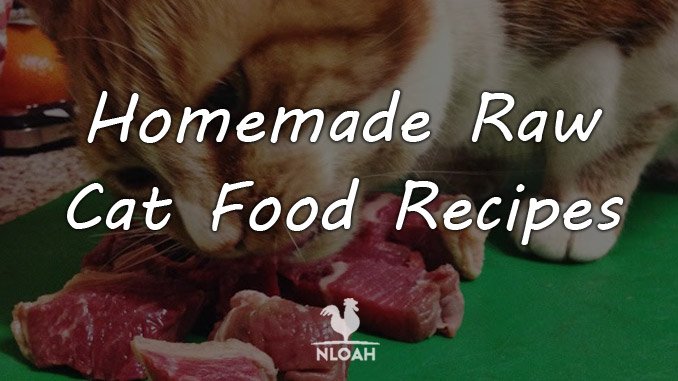
Raw feeding for cats and dogs is becoming increasingly popular, and for good reason. With commercial cat food containing everything from indigestible grains to contaminated ingredients to harmful additives, a raw, species-appropriate diet is really the best way forward.
The Benefits of Raw Feeding Your Cat
Cats are obligate carnivores, which means that they should only be eating meat, and not much else. However, not only does commercial cat food usually contain no more than a 3-4% meat, this tends to be a by-product, meaning that there is not much nutrition to it.
By switching to a raw food diet, you will soon notice your cat beginning to look and feel better. Here are a few of the benefits:
- A shinier coat and healthier skin
- Clean, white teeth and better breath
- Smaller, less smelly, stools
- Better immune system
- Easier weight management
- Improved digestion
- Higher gut acidity, which is better for destroying pathogens
- More energy
- Less allergies
- Better overall health
One of the other benefits that is often not mentioned is hydration. Cats have a high thirst drive, but are not naturally good at drinking enough water. The reason for this is because cats are designed to obtain their main source of water from their food, since 70% of whole prey, be it a mouse, a rabbit or a bird, is made up of water.
By switching to a raw diet, your cat will get most of its water intake from food, and will be able to stay hydrated much better.
Take a look at this video, which features top vet Dr. Karen Becker, discussing the benefits:
Here is another video in which seven vets discuss the benefits :
Raw Feeding Risks
One of the main issues that people have with raw diets for pets is that it could pose a health risk to humans, but preparing raw food for your cat is no different to preparing meat for humans. Good hygiene and cleanliness needs to be practiced for both, such as washing your cat’s bowl after each meal, and cleaning surfaces after meat has been on them.
When it comes to health risks, salmonella is one that people worry about. However, salmonella is found in the GI tract of 18% of cats, no matter what they eat. It is naturally present in the environment, and naturally shed through their feces and saliva, even if they are on a dry food diet.
In fact, there have been more recalls for dry pet food due to dangerous levels of salmonella than their have for raw food.
There are quite a few other raw feeding myths out there, and it’s worthwhile familiarizing yourself with these at the beginning of your raw journey.
Here are a few common questions:
Many veterinarians are against raw diets for cats, shouldn’t you be listening to them?
Those same veterinarians have also likely undergone little training in pet nutrition. Those who have, such as qualified pet nutritionists, are much more likely to be aware of the advantages that a raw diet has.
Many veterinarians also tend to see a large number of owners feed an unbalanced raw diet, resulting in a malnourished cat. This is why it is important to educate yourself before starting out, to ensure you are providing your cat a healthy, balanced diet.
Won’t your cat choke on bones?
No, but the important point to emphasize here is that the bones need to be raw. Cooked bones splinter when chewed, causing everything from choking to intestinal punctures. However, when raw bones are chewed, they have clean edges, which are then worn down into smooth surfaces by your cat’s stomach acid, meaning that they don’t cause any damage as they travel through the body.
Don’t cats live longer on a cooked diet?
Commercial diets have only been around for 50 years or so, and, in that same time, there has been a significant rise in obesity, diabetes and cancer in cats. The connection between the two cannot be ignored, especially when you take a look at how much healthier raw fed cats tend to be.
This video will talk you through a few other raw feeding myths:
Raw Diets vs Cooked Diets
While cooked diets can be better than commercial diets, raw diets still tend to surpass cooked diets.
One reason for this is that the process of cooking transforms the nutrients found in meat, altering their composition and making them less bio-available to your cat.
Cooking also degrades the nutrients, meaning that you lose out on so many amino acids, vitamins and minerals, which would have otherwise been present in the meat in its raw form.
In order to compensate for the deficiencies of a cooked diet, you would need to add in a number of different supplements, and this then becomes really difficult to properly balance out.
Figuring Out the Daily Amounts
Before you can work out how much food you need to feed your cat each day, you need to know his or her weight.
A simple way to weigh your cat, especially if they don’t stay on the scale by themselves is to weigh yourself first. Then, pick your cat up and weigh the two of you together. Subtract your weight from the weight of both of you, and you’re left with your cat’s weight.
Generally, you should be feeding your cat between 2-4% of their body weight each day, although you can double this if you are feeding a kitten, up until a year old. It is usually best to stick with two meals for an adult cat, and four meals for a kitten.
If your cat is overweight, start with 2% until the weight has dropped down to an ideal level, after which you can increase it slowly, until you find a percentage that maintains your cats ideal weight.
If your cat is extremely active and lean, go with 4%.
If you are not sure, start with 3%, and adjust this up and down when needed. Ideally, you should be able to feel your cat’s ribs, but not see them, and this should give you a good indication of whether or not you need to feed more or less.
Since you will likely be feeding your cat twice a day, you need to divide this daily amount by two, in order to work out how much you need to feed each meal.
When it comes to what actually makes up your cat’s raw meals, here is the breakdown:
- 83% of their meal needs to be meat
- 7% of their meal needs to be bone
- 5% of their meal needs to be liver
- 5% of their meal needs to be another secreting organ
Keep in mind that when you are feeding a bone, there is still going to be some meat attached to it, meaning that the weight of that bone would account for some of the meat requirements, as well as the bone requirements.
Here are some guidelines when it comes to understanding how much of each bone is actually bone:
| Bone Type | Actual Bone Content in % |
| Chicken neck, with skin | 36% |
| Chicken neck, without skin | 75% |
| Chicken back | 44% |
| Chicken foot | 60% |
| Chicken rib cages | 88% |
| Chicken wing | 46% |
| Duck neck | 50% |
| Duck wing | 39% |
| Whole rabbit, with pelt | 10% |
| Whole rabbit, without pelt | 28% |
| Pork and lamb ribs | 45% |
Here is an example of what it all means:
If your cat weighs 11lbs (5kg) and is already at an ideal weight, then 3% of their body weight would be 150g. This is the amount you would need to feed each day:
83% of 5,29 oz or 150 g needs to be meat, which works out to 4.39 oz or 124.5 g.
7% of 5,29 oz or 150 g needs to be bone, which works out to 0.37 oz or 10.5 g.
5% of 5,29 oz or 150 g needs to be liver, which works out to 0.26 oz or 7.5 g.
5% of 5,29 oz or 150 g needs to be another organ, which works out to 0.26 oz or 7.5 g.
If you were to include a chicken wing, which has 46% bone, into their meal, and it weighs 100g, then this means that 46g of that chicken wing is bone, and the remaining 54g would count as meat.
While the recipes below do take these percentages into account, it is still important to understand them for yourself, especially if you plan on adapting the recipes.
These calculations can seem confusing at first, and do end up putting many off raw feeding. However, once you have done them, you will likely not need to do them again, and, even if you do, raw feeding will have quickly become second nature by then.
It is also important to remember that all of these percentages are just guidelines. As you get more accustomed to raw feeding, you will end up adjusting these to suit the needs of your individual cat.
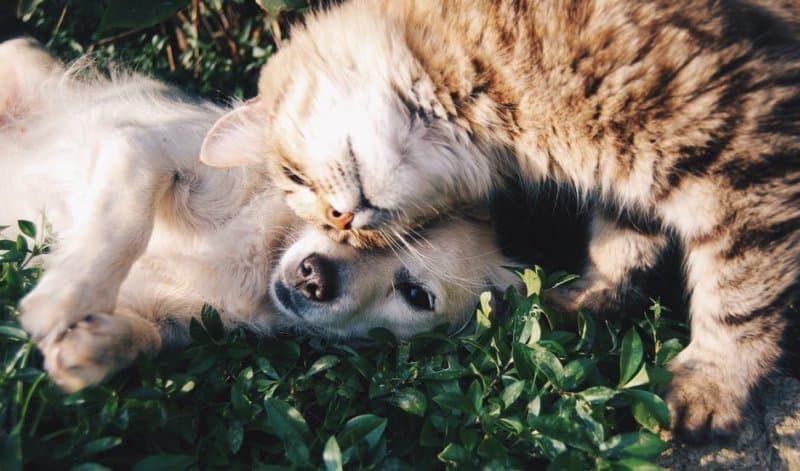
Already Raw Feeding a Dog?
If you already raw feed a dog, you will likely already be aware of the 80/10/5/5 guidelines. The reason why the guidelines for cats is slightly different is because the prey that cats would naturally catch would not be the same as dogs. For example, rodents contain just 5% bone and 4% liver, while rabbits contain less than 10% bone and 4% liver, and birds are even lower in both bone and organ content.
Another difference between raw feeding cats and dogs is that cats, unlike dogs, cannot create taurine in their bodies, so you do need to be aware of the differing taurine contents in certain meats. This will be explained in more detail further down.
Transitioning Your Cat to a Raw Diet
To Grind or Not To Grind?
If you are transitioning a kitten to a raw diet, then chances are that this will be extremely easy. Usually, the younger the cat, the quicker they will adapt, and they seem to instinctively know what their body needs.
However, when it comes to adult cats, this can be slightly trickier…
If your cat is currently eating kibble, you have a couple of options. Kibble is like junk food to cats, so the majority do not easily switch straight over to raw.
Instead, you can either move him over from kibble to a canned food, and then begin swapping parts of this out for a ground up raw food.
Alternatively, you can start mixing his kibble in with the ground up raw food, gradually reducing the amount of kibble that you include, until you can completely cut it out.
While it may be tempting to practice tough love, and simply not feed your cat anything else until he eats the raw food, this is something that you should never do. Cats have a unique predisposition to contracting hepatic lipidosis, which is a form of liver failure that can occur if the cat does not eat for 24 hours.
This means that you must make the transition to raw at your cat’s own pace, rather than trying to rush him through it.
Here are a few other tips that you can try out to encourage your cat to eat the raw food:
- Drizzle it with some of the juice from a can of tuna
- Mix in a small amount of grated cheese
- Crumble some dried liver over the top
- Sprinkle some crushed kibble, or any other treat that your cat loves, over the top
If you already prepare meat to cook at home for human consumption, there is nothing wrong with offering different cuts of meat to your cat to try. You may find that your cat absolutely adores a certain protein, which means this is the protein to begin with when transitioning your cat.
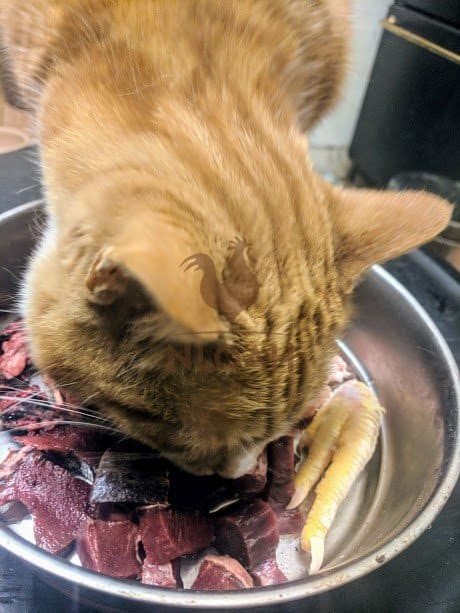
To Grind or Not To Grind?
Grinding raw food is one of the most popular ways of raw feeding cats, and this is because the final texture is similar to that of the canned foods that cats are already accustomed to, making for an easy transition to the raw version.
This is also a great way to feed elderly cats, who may be missing a few teeth.
However, the fact that ground food does not require any chewing is also a downside to younger cats, as the chewing and tearing of the meat, and the crunching of the bones, is a great way to keep their teeth clean.
Grinding can also degrade quite a few nutrients within the meat, so, if this is how you are going to feed the recipes below, you will need to add in a few extra supplements. Scroll down to the Supplements section for more.
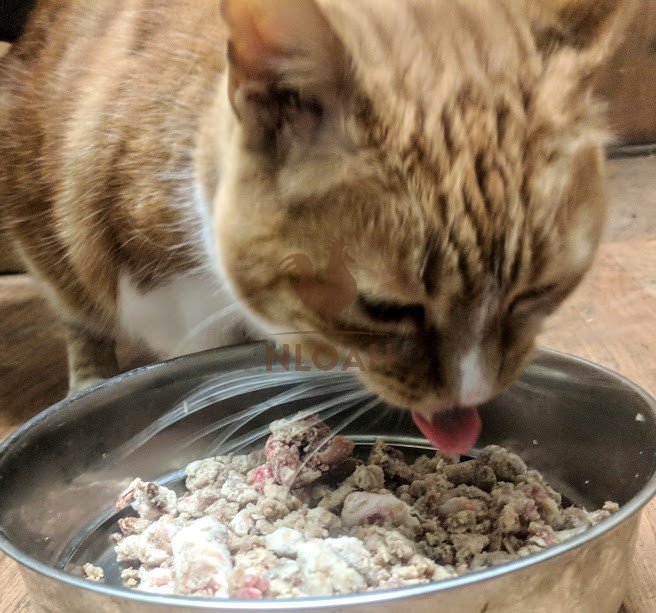
Raw Cat Food Recipes
The recipes below are designed to be served up as small chunks, or even larger chunks if your cat enjoys working for his food.
Keep in mind that the bones that cats are able to eat are quite limited, and, for some of the proteins mentioned below, such as beef, there are no bones that would be suitable for a cat. In those cases, the bones have been replaced with alternatives.
When it comes to adding water into each of these recipes, this depends on whether or not you feel your cat could do with the extra hydration. It also depends on the consistency of food that your cat prefers – if he likes it wetter and sloppier, then definitely add in some extra water.
All of these recipes make around 1kg of food. The number of days that this will last for depends on the amount that you will be feeding your cat each day. You may find it more convenient, as well as cost-effective, to double or triple these batches when making them.
Recipe 1: Chicken-Based
Ingredients
- 350g chicken thigh meat
- 200g chicken heart
- 50g chicken gizzard
- 300g chicken neck, with skin
- 50g chicken liver
- 50g chicken kidney
- 50g sardines
- 1 raw chicken egg
- Water (optional)
Method
- Chop all of the ingredients up into chunks, leaving the thigh meat as larger chunks and the offal into smaller chunks
- Place everything into a large bowl or bucket and mix in the egg.
- Weigh out what your cat needs on a daily basis and then portion this up into containers.
Recipe 2: Beef-Based
- 200g beef steak
- 200g beef mince (make sure this contains no additives, such as salt or onions)
- 100g beef lips
- 100g beef tongue
- 100g beef heart
- 200g chicken wing
- 50g beef liver
- 50g beef spleen
- 50g sardines
- 1 raw duck egg
- Water (optional)
Method
- Slice the steak, tongue, lung and heart.
- Chop the chicken wings into two or three pieces each.
- Chop the liver and spleen into small chunks.
- Place everything into a large bowl or bucket and mix in the egg.
- Weigh out what your cat needs on a daily basis and then portion this up into containers.
Recipe 3: Lamb-Based
Ingredients
- 200g lamb leg meat
- 200g lamb shoulder meat
- 100g lamb lung
- 200g lamb heart
- 200g chicken back
- 50g lamb liver
- 50g lamb kidney
- 50g sprats
- 4 quail eggs
- Water (optional)
Method
- Chop the leg, shoulder, heart and sprats into chunks.
- Hack the chicken back into slivers that would be an easy size for your cat to chew on
- Chop the liver and kidney into small chunks.
- Place everything into a large bowl or bucket and mix in the eggs.
- Weigh out what your cat needs on a daily basis and then portion this up into containers.
Recipe 4: Pork-Based
Feeding raw pork to cats can be quite a controversial topic, with some believing it is dangerous, but others believing the opposite. This also depends on where you live, as pork from different parts of the world can carry different parasites. If you are unsure about feeding pork, do some extra research on pork from your area, and speak to other local raw feeders to see what information they may have.
Ingredients
- 200g pork loin
- 200g pork leg meat
- 100g pork cheek
- 300g pork mince
- 100g chicken rib cage
- 50g pork liver
- 50g pork testicles
- 50g mackerel
- 1 chicken egg
- Water (optional)
Method
- Cut the rib cages into bite-sized pieces.
- Chop the pork meat and mackerel into chunks.
- Chop the liver and testicles into smaller chunks.
- Place everything into a large bowl or bucket and mix in the eggs.
- Weigh out what your cat needs on a daily basis and then portion this up into containers.
Recipe 5: Rabbit-Based
Rabbits can often be purchased whole but gutted, along with their fur, which many believe acts as a natural wormer.
Whole rabbits weigh a couple of kilograms each, and, if you are able to purchase a whole rabbit, all you really need to do is chop the whole thing up into bite-sized pieces. You could also ask a local butcher to break the rabbit down for you.
This is an example of feeding whole prey, which will be explained in more detail further down.
Recipe 6: Turkey-Based
Ingredients
- 400g turkey thigh meat
- 100g turkey breast meat
- 200g turkey heart
- 200g chicken back
- 50g turkey liver
- 50g turkey kidney
- 50g sardines
- 1 duck egg
- Water (optional)
Method
- Cut the chicken back into bite-sized pieces.
- Chop the turkey meat and mackerel into large chunks.
- Chop the liver and kidney into smaller chunks.
- Place everything into a large bowl or bucket and mix in the egg.
- Weigh out what your cat needs on a daily basis and then portion this up into containers.
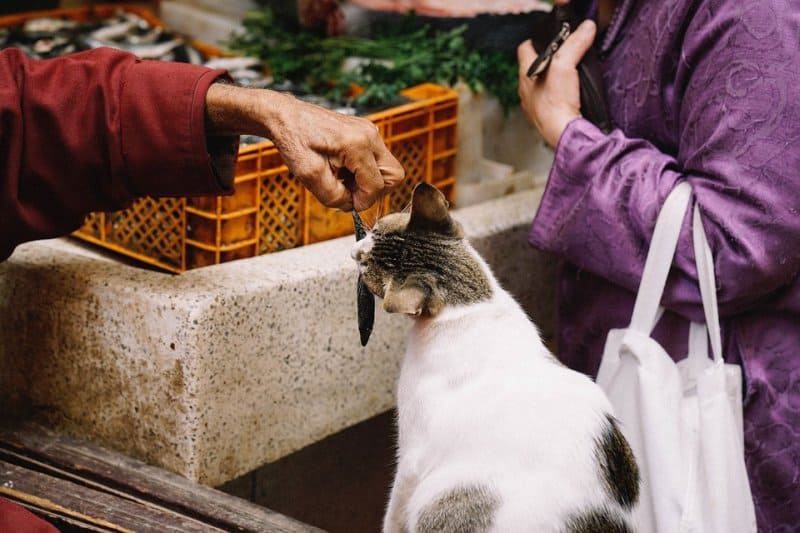
Feeding Fish
While many people believe that fish should make up a large part of a cat’s diet, this is not actually true. While fish does contain omega-3 and omega-6 fatty acids, making them essential, this should still be kept to a minimum.
One reason for this is due to the toxins and pollutants that are found in fish, as well as the antibiotics. To avoid this, opt for wild fish rather than farmed fish.
Sardines or sprats tend to be one of the best varieties to feed, and this can be both fresh or canned. If you are opting for the canned version, make sure you check the salt levels before feeding, and pick the ones that have been preserved in water rather than oil or a sauce.
If you would prefer not to feed fish, you can replace the fish in these recipes with a drop of fish oil a day. Make sure that you do not forget to replace the weight of the fish with a meat alternative.
Adapting Recipes and Mixing Proteins
Each of the recipes mentioned above can be adapted based on what meat you have available to you.
Once you understand how much meat, bone and offal your cat needs, you can mix and match to your heart’s desire.
Here are some ideas of other cuts of meat, offal and bone that you could feed:
| Meat | Offal | Bone |
| Heart | Liver | Wings |
| Tongue | Kidney | Ribs |
| Lung | Pancreas | Necks |
| Fillets | Testicles | Carcass |
| Off cuts | Brain | |
| Cheek | Spleen | |
| Trachea | ||
| Gizzard | ||
| Brisket | ||
| Penis | ||
| Green tripe |
In addition to making up batches of cat food in advance, you also have the option of measuring out what your cat needs on a daily basis. You can then split this up into two meals.
For example, the bowl in the image below contains:
- A chicken foot (keep in mind that this may be too hard for some cats to chew)
- Turkey chunks
- Beef heart chunks
- Lamb leg off-cuts
- A quail egg
- Homemade kefir for probiotics
The evening meal will consist of lamb liver, beef kidney, and some chicken chunks.
While this style of feeding does mean that your cat would be able to enjoy more variety on a daily basis, It would only really work if you are able to always have some defrosted bone, offal and meat in your fridge.
However, if your cat is quite a picky eater, this can be a great way to work out exactly what he actually likes, so that you can base your meals around those proteins.
Feeding Whole Prey
Feeding whole prey is exactly what it sounds like – feeding whole animals. This is as close as you can get to a cat’s natural diet, containing the ideal balance of everything a cat needs, and requires little to no preparation.
Here are some examples of whole prey that you can feed, feather and fur included:
- Mice and rats
- Quail
- Day old chicks and ducklings
- Hamsters
- Rabbits
- Partridge
- Guinea pigs
- Chicks
- Ducklings
- Small fish
How to Store Raw Cat Food
When putting together raw cat food, it’s always easier to do this in large batches. However, as with all raw meat, it cann’t be stored for more than a few days in the fridge.
This is where your freezer comes in. Simply store two days’ worth of cat food in your fridge, and each time you take a box out, replace it with a box from the freezer, so that it has defrosted by the time you need it.
If you bought a large piece of meat, such as a whole lamb’s liver, and only need a small portion of it to create your batch, there is nothing wrong with defrosting it, taking what you need, and then re-freezing it. The only thing that this will affect is the texture, which is why humans do not tend to do this.
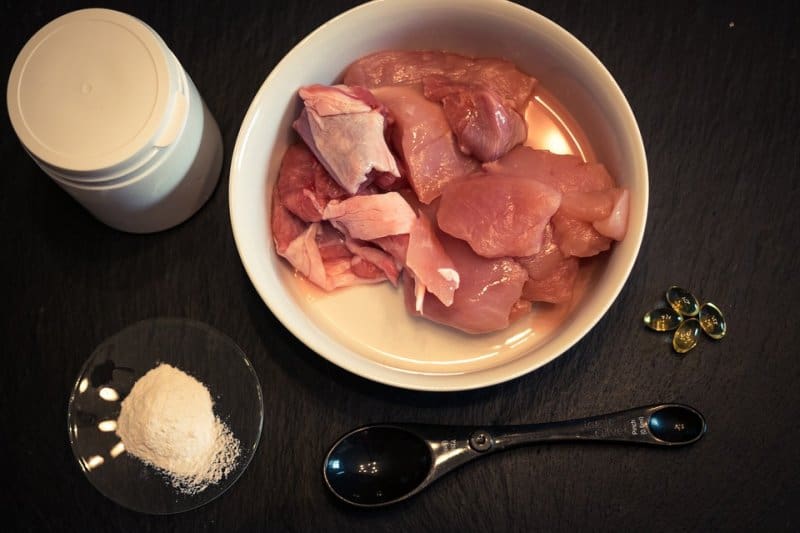
Adding Supplements
Many raw feeders add supplements into their cat’s food, and this is something that only you will be able to decide for yourself with more research.
If you are feeding a balanced diet, with a variety of different proteins, as well as some whole prey, then supplements will not generally be needed.
If you are choosing not to feed fish, then you will need to feed a fish oil instead. While omega-3 and omega-6 fatty acids used to be found in beef and poultry, this is no longer the case, unless you are able to source solely grass-fed proteins. When it comes to choosing a fish oil, go for a salmon oil or a small fish oil. Stay away from cod liver oil, as this contains too much vitamin A, especially since you are already feeding liver.
Taurine is another supplement that is commonly added in to raw cat food. This is a type of amino acid that is essential when it comes to your cat’s health. Taurine can be found in just about every muscle meat, and, generally, the harder working the muscle, the more taurine it contains. This is why heart is included in every recipe above.
Grinding your cat’s food causes the taurine in meat to oxidize, decreasing the amount that is available to your cat. For this reason, if you grind your cat’s food, it would be wise to add in some extra taurine. Do not worry about overdoing this, because any excess taurine will simply be expelled in your cat’s urine.
One final supplement that you may wish to add is a probiotic. These boost the immune system and aid in so many different parts of your cat’s health.
Of course, there are plenty of other natural supplements out there for different health issues. From arthritis to lack of energy, if your cat does have a specific issue that you would like to address, it would be worth looking into the various supplements available.
Substituting Bone for Calcium Supplements
There is nothing that can really replace the goodness that real bones can bring, especially since they contain the ideal ratio of calcium to phosphorous. However, if for some reason you cannot feed bone for a while, there are a couple of calcium supplements that you could try.
Bone meal is one of the most common, but make sure that you buy the version formulated for human consumption, rather than for in the garden.
Crushed eggshells are also a great calcium source, but be wary of using store-bought eggshells, as these may have been bleached or chemically sprayed. If you have laying poultry on your homestead, then you already have a great calcium supplement freely available to you.
This video will talk you through how to make eggshell powder:
However, keep in mind that this is only advisable for a short term period, and you need to switch back to feeding bone, even if it is in its ground up form, as soon as possible.
Keeping an Eye on Stool
Your cat’s stools can tell you so much about their diet and health, which is why it is important to keep a close eye on this, especially when transitioning them to a new diet.
If your cat seems to be constipated, and is producing stools that are white and crumbly, then this is an indication that you have fed too much bone. Feed a boneless meal for the next meal, and the stools should go back to normal.
If your cat’s stools are loose, runny and dark in color, then this is an indication that you have fed too much offal or heart. While some cats can tolerate a large amount of heart in their diet, others cannot, so this is something that will need to be adjusted based on your individual cat.
Should You Be Including Fruits and Vegetables?
As mentioned above, cats are obligate carnivores, which means that they do not need any fruits and vegetables in their diet. They also have a difficult time digesting them, so you should really try to avoid feeding these as much as possible.
However, if your cat has taken a particular liking to a fruit or vegetable, this will not do any harm when fed on occasion, as long as you have checked that that particular food is safe to feed to cats.
Treats and Snacks for Raw Fed Cats
Even though you feed your cat a raw diet, you can still use commercial treats on occasion. However, these do contain additives and other harmful ingredients, so, if you are wanting to pay extra attention to your cat’s health and nutrition, it would be best to avoid these.
However, if you are able to find commercial cat treats that contain nothing but meat, then this should be no problem, but make sure that you are aware of the meat’s origin.
Alternatively, you could try making your own treats at home. If you have a dehydrator, you are likely already aware of how to dehydrate meat. Simply cut the meat into thin slices, dehydrate them, and feed them to your cat as a treat.
If you do not have a dehydrator, you could dehydrate meat in your oven, keeping it on at its lowest temperature, with the door slightly ajar so that moisture can escape.
Here’s how to dehydrate some simple chicken treats:
Where to Source Your Meat From
Initially, many people tend to find raw feeding more expensive, but, once you get into the swing of things, you will learn how to source your meat for cheaper.
Local butchers will often have off cuts, as well as bones, that they are willing to give away for free, as will local farmers and hunters. Hunters in particular could be a great source of whole prey for your cat, especially rabbits.
There are also more and more raw suppliers popping up all over the world. They will not only sell everything that you need to put together a homemade raw diet for your cat, but will also sell complete mixes, meaning that all the hard work will have already been done for you. While these are more costly, they are great for those days when you have run out of cat food but do not have the time to whip up another batch.
Learn Even More
Raw feeding can be intimidating to begin with, and there is no denying that there is so much to learn. In fact, even seasoned raw feeders are constantly learning.
While most veterinarians are trained when it comes to raw feeding, pet nutritionists will, so if you would like some advice tailored to your individual cat, it’s worth contacting one.
There are also plenty of books out there that will teach you more about cat nutrition. If you would prefer to watch something rather than read, take a look at the Netflix documentary called Pet Fooled, as this will teach you so much about the dark side of the pet food industry.
Finally, don’t dismiss the power of social media. There are so many raw feeding groups and forums out there, and these are moderated by raw feeders who have so many years of experience. These are always so useful when you have an urgent question that needs answering, or if you would simply like to find a mentor to help you along the way.
Summary
Being the closest thing to a completely natural diet, raw feeding will do so much good for your cat. While there is so much to learn, do not feel overwhelmed, as it will not be long before you begin to get the hang of things.
Post a comment below if you have any questions about raw feeding, or would like to know more about tailoring a raw diet to your cat’s individual needs.
Disclaimer: Neither the author nor New Life On a Homestead shall be held liable for the negative effects that result from using the advice in this article. Before employing any of the advice in this article, please contact your pet’s veterinarian.

https://www.newlifeonahomestead.com/homemade-raw-cat-food-recipes/
On – 25 Nov, 2017 By Alina J



